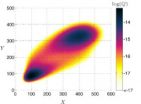(Press-News.org) Chromosomal abnormalities that result in birth defects and genetic disorders like Down syndrome remain a significant health burden in the United States and throughout the world, with some current prenatal screening procedures invasive and a potential risk to mother and unborn child.
In a paper published online this week in the Early Edition of PNAS, a team of scientists at the University of California, San Diego School of Medicine and in China describe a new benchtop semiconductor sequencing procedure and newly developed bioinformatics software tools that are fast, accurate, portable, less expensive and can be completed without harm to mother or fetus.
"We believe this approach could become the standard of care for screening of prenatal chromosomal abnormalities," said Kang Zhang, MD, PhD, professor of ophthalmology, founding director of the Institute for Genomic Medicine at UC San Diego and a staff physician at the San Diego VA Healthcare System.
The incidence of chromosomal abnormalities – in numbers or structure – is one in 160 live births in the United States, higher in other countries. In China, for example, the rate is one in 60 live births. The effects of these abnormalities, known as aneuploidies, can be severe, from developmental delays and neurological disorders to infertility and death. The incidence rate rises with maternal age, most notably after age 35.
Current diagnoses of fetal aneuploidies often rely upon invasive tests that sample amniotic fluid or placental tissues for fetal DNA that can then be analyzed using a variety of complex and expensive methods, including full karyotyping in which the entire set of chromosomes is viewed microscopically. While highly reliable, these invasive tests may cause infections in the pregnant woman and pose as much as a 1 percent risk of miscarriage and fetal loss. Results are not available for one to two weeks, extending anxiety for families waiting for information.
The new method relies upon massively parallel sequencing of cell-free fetal DNA using a benchtop semiconductor sequencing platform (SSP) called an Ion Torrent sequencer developed by Life Technologies. Cell-free fetal DNA is genetic material from the fetus that circulates naturally and freely in the mother's bloodstream. It can be obtained through an ordinary blood draw, with SSP analysis achieved in less than four days.
To assess the SSP method, researchers tested 2,275 pregnant women. More than 500 participated in a retrospective analysis, undergoing full karyotyping to establish known chromosomal abnormalities followed by SSP testing. The remainder participated in a prospective study without prior karyotyping, and SSP testing results were then compared to karyotyping results. The sequencing and automated bioinformatics analyses were performed at iGenomics in Guangzhou, China.
"We used the retrospective study to establish the method and the prospective study to validate it," said Zhang.
In the retrospective study, the researchers found that SSP detected multiple types of chromosomal abnormality with virtually 100 percent sensitivity and specificity compared to full karyotyping.
"To our knowledge, this is the first large-scale clinical study to systematically identify chromosomal aneuploidies based on cell-free fetal DNA using SSP," said Zhang. "It provides an effective strategy for large-scale, noninvasive screenings in a clinical setting. It can be done in hospitals and outpatient clinics, more quickly and cheaply."
INFORMATION:Co-authors are Can Liao, Fang Fu, Ru Li, Yong-ling Zhang, Yan-mei Ou, Jian Li and Dong-zhi Li, Guangzhou Medical University, China; Ai-hua Yi, Jie-xia Yang, Jing Wu, Ming-qin Mai and Xiao-zhuang Zhang, Guangdong Women and Children Hospital, China; Chun-fang Peng, Yang-yi Chen, Dong-hong Luo and Hai-liang Liu, iGenomics Co., Guangzhou, China; Rui Hou, Guangzhou Kang Rui Biological Pharmaceutical Technology Co, Guangzhou, China; Frances Wu, UCSD Institute for Genomic Medicine and UCSD Department of Ophthalmology; and Hongrong Luo, UCSD Institute for Genomic Medicine and UCSD Department of Ophthalmology and Sichuan University, China.
Funding for this research came, in part, from the National Natural Science Foundation of China, National Science Foundation for Young Scholars of China, National Natural Science Foundation of Guangdong, Key Project of Guangzhou Health Bureau, Major Project of Guangzhou Science and Technology and Information Bureau, 973 program and Burroughs Wellcome Fund.
Detecting fetal chromosomal defects without risk
Noninvasive sequencing is faster, cheaper and safer for mother and fetus, say researchers
2014-05-06
ELSE PRESS RELEASES FROM THIS DATE:
Working to cure 'dry eye' disease
2014-05-06
WASHINGTON D.C. May 6, 2013 -- The eye is an exquisitely sensitive system with many aspects that remain somewhat of a mystery—both in the laboratory and in the clinic.
A U.S.-based team of mathematicians and optometrists is working to change this by gaining a better understanding of the inner workings of tear film distribution over the eye's surface. This, in turn, may lead to better treatments or a cure for the tear film disease known as "dry eye." They describe their work in the journal Physics of Fluids.
Dry eye disease afflicts millions of people worldwide, with ...
Predator-prey made simple
2014-05-06
WASHINGTON D.C. May 6, 2013 -- A team of U.K. researchers has developed a way to dramatically reduce the complexity of modeling "bistable" systems which involve the interaction of two evolving species where one changes faster than the other ("slow-fast systems"). Described in The Journal of Chemical Physics, the work paves the way for easier computational simulations and predictions involving such systems, which are found in fields as diverse as chemistry, biology and ecology.
Imagine, for instance, trying to predict how a population of whales would fare based on the ...
A cup of coffee a day may keep retinal damage away
2014-05-06
ITHACA, N.Y. – Coffee drinkers, rejoice! Aside from java's energy jolt, food scientists say you may reap another health benefit from a daily cup of joe: prevention of deteriorating eyesight and possible blindness from retinal degeneration due to glaucoma, aging and diabetes.
Raw coffee is, on average, just 1 percent caffeine, but it contains 7 to 9 percent chlorogenic acid, a strong antioxidant that prevents retinal degeneration in mice, according to a Cornell study published in the Journal of Agricultural and Food Chemistry.
The retina is a thin tissue layer on the ...
Expert guidance strengthens strategies to prevent most common and costly infection
2014-05-06
CHICAGO (May 6, 2014) – Surgical site infections (SSIs) are the most common and costly healthcare-associated infection (HAI) in the United States. New evidence-based recommendations provide a framework for healthcare institutions to prioritize and implement strategies to reduce the number of infections.
The guidelines are published in the June issue of Infection Control and Hospital Epidemiology and were produced in a collaborative effort led by the Society for Healthcare Epidemiology of America, the Infectious Diseases Society of America, the American Hospital Association, ...
New expert guidelines aim to focus hospitals' infectious diarrhea prevention efforts
2014-05-06
CHICAGO (May 6, 2014) – With rates of Clostridium difficile (C. difficile) now rivaling drug-resistant Methicillin-resistant Staphylococcus aureus (MRSA) as the most common bacteria to cause healthcare-associated infections, new expert guidance encourages healthcare institutions to implement and prioritize prevention efforts for this infectious diarrhea. The guidelines are published in the June issue of Infection Control and Hospital Epidemiology.
The new practice recommendations are a part of Compendium of Strategies to Prevent Healthcare-Associated Infections in Acute ...
As kids age, snacking quality appears to decline
2014-05-06
PROVIDENCE, R.I. [Brown University] — The average U.S. child snacks three times a day. Concerned about the role of snacking in obesity, a team of researchers set out to explore how eating frequency relates to energy intake and diet quality in a sample of low-income, urban schoolchildren in the Boston area. They expected that snacking would substantially contribute to kids' overall energy intake, and the new data confirm that. But they were surprised that the nutritional value of snacks and meals differed by age.
The findings, led by first author E. Whitney Evans, a ...
Planck reveals magnetic fingerprint of our galaxy
2014-05-06
The team—which includes researchers from the University of British Columbia and the Canadian Institute for Theoretical Astrophysics (CITA) at the University of Toronto—created the map using data from the Planck Space Telescope. Since 2009, Planck has charted the Cosmic Microwave Background (CMB), the light from the Universe a mere 380,000 years after the Big Bang.
But Planck also observes light from much closer than the farthest reaches of time and space. With an instrument called the High Frequency Instrument (HFI), Planck detects the light from microscopic dust particles ...
GW researcher discovers the mechanisms that link brain alertness and increased heart rate
2014-05-06
WASHINGTON (May 6, 2014) — George Washington University (GW) researcher David Mendelowitz, Ph.D., was recently published in the Journal of Neuroscience for his research on how heart rate increases in response to alertness in the brain. Specifically, Mendelowitz looked at the interactions between neurons that fire upon increased attention and anxiety and neurons that control heart rate to discover the "why," "how," and "where to next" behind this phenomenon.
"This study examines how changes in alertness and focus increase your heart rate," said Mendelowitz, vice chair ...
Scientists identify new protein in the neurological disorder dystonia
2014-05-06
MANHATTAN, Kan. — A collaborative discovery involving Kansas State University researchers may lead to the first universal treatment for dystonia, a neurological disorder that affects nearly half a million Americans.
Michal Zolkiewski, associate professor of biochemistry and molecular biophysics at Kansas State University, and Jeffrey Brodsky at the University at Pittsburgh co-led a study that focused on a mutated protein associated with early onset torsion dystonia, or EOTD, the most severe type of dystonia that typically affects adolescents before the age of 20. Dystonia ...
International team maps nearly 200,000 global glaciers in quest for sea rise answers
2014-05-06
An international team led by glaciologists from the University of Colorado Boulder and Trent University in Ontario, Canada has completed the first mapping of virtually all of the world's glaciers -- including their locations and sizes -- allowing for calculations of their volumes and ongoing contributions to global sea rise as the world warms.
The team mapped and catalogued some 198,000 glaciers around the world as part of the massive Randolph Glacier Inventory, or RGI, to better understand rising seas over the coming decades as anthropogenic greenhouse gases heat the ...
LAST 30 PRESS RELEASES:
Making lighter work of calculating fluid and heat flow
Normalizing blood sugar can halve heart attack risk
Lowering blood sugar cuts heart attack risk in people with prediabetes
Study links genetic variants to risk of blinding eye disease in premature infants
Non-opioid ‘pain sponge’ therapy halts cartilage degeneration and relieves chronic pain
AI can pick up cultural values by mimicking how kids learn
China’s ecological redlines offer fast track to 30 x 30 global conservation goal
Invisible indoor threats: emerging household contaminants and their growing risks to human health
Adding antibody treatment to chemo boosts outcomes for children with rare cancer
Germline pathogenic variants among women without a history of breast cancer
Tanning beds triple melanoma risk, potentially causing broad DNA damage
Unique bond identified as key to viral infection speed
Indoor tanning makes youthful skin much older on a genetic level
Mouse model sheds new light on the causes and potential solutions to human GI problems linked to muscular dystrophy
The Journal of Nuclear Medicine ahead-of-print tip sheet: December 12, 2025
Smarter tools for peering into the microscopic world
Applications open for funding to conduct research in the Kinsey Institute archives
Global measure underestimates the severity of food insecurity
Child survivors of critical illness are missing out on timely follow up care
Risk-based vs annual breast cancer screening / the WISDOM randomized clinical trial
University of Toronto launches Electric Vehicle Innovation Ontario to accelerate advanced EV technologies and build Canada’s innovation advantage
Early relapse predicts poor outcomes in aggressive blood cancer
American College of Lifestyle Medicine applauds two CMS models aligned with lifestyle medicine practice and reimbursement
Clinical trial finds cannabis use not a barrier to quitting nicotine vaping
Supplemental nutrition assistance program policies and food insecurity
Switching immune cells to “night mode” could limit damage after a heart attack, study suggests
URI-based Global RIghts Project report spotlights continued troubling trends in worldwide inhumane treatment
Neutrophils are less aggressive at night, explaining why nighttime heart attacks cause less damage than daytime events
Menopausal hormone therapy may not pose breast cancer risk for women with BRCA mutations
Mobile health tool may improve quality of life for adolescent and young adult breast cancer survivors
[Press-News.org] Detecting fetal chromosomal defects without riskNoninvasive sequencing is faster, cheaper and safer for mother and fetus, say researchers


